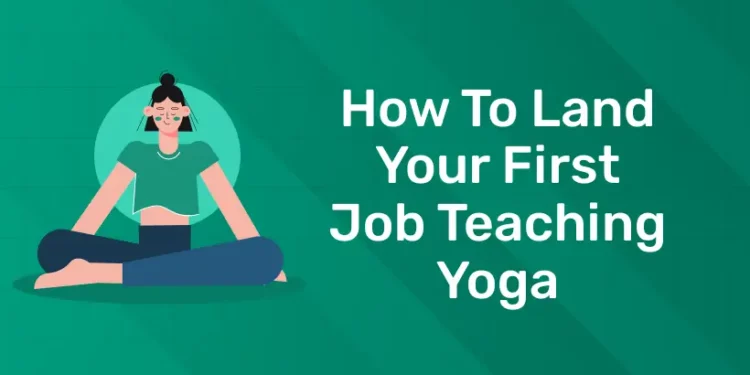Table of Contents
Being a yoga instructor is a fascinating adventure that offers many chances for both professional and personal development. Getting your first yoga teaching job is a big deal, regardless of whether you’re a freshly certified instructor or someone hoping to make the switch to a full-time employment. We’ll go over practical methods and approaches in this extensive book to help you land your first yoga teaching position and launch a successful career in the exciting field of yoga instruction.
Getting hired for the first time as a yoga instructor is an exciting turning point in your career. You can land your first job teaching yoga and start a rewarding career imparting the life-changing practice of yoga to others by honing your skills, getting teaching experience, networking within the yoga community, strategically preparing your application materials, and being persistent in your job search.
Get Certified, Get Confident! Join Our Yoga Teacher Training Course!
How to Land Your First Job as Yoga Teacher
Practice Everywhere
- If you are not a resident of the studio, very few will even consider you for a position. As you may have discovered during your teacher training, community plays a significant role in yoga, but so does discipline.
- When you practise at a studio, you get the opportunity to get to know the other students and determine whether or not this is the suitable community for you.
- Many teachers apply for teaching positions at studios they have never visited; they either never hear back from them or are passed over for a position because the people who make the recruiting choices are just unfamiliar with them.
- Your ability to engage with others increases when you attend classes regularly, which makes it easier for you to become more naturally linked for a teaching position.
- A warning about this gym. You can easily apply in person for many teaching openings at gyms by bringing your CV or contacting them online.
Getting on a sub list in a Studio
- The majority of yoga instructors begin their careers by signing up for the studio’s substitute list. Reaching out to the studio where you finished your training is a smart place to start.
- Yoga studios typically prefer to hire their own graduates since it shows off the effectiveness and calibre of their students and serves to draw attention to their training from other prospective students. Furthermore, the student body at this studio is probably familiar with you and will feel more at ease having you as an instructor if you regularly attend.
- You will almost certainly have opportunities to substitute and teach if your schedule is flexible, as many studios require subs in case of illness, emergency, or vacations.
- One very important thing to remember is that, as a substitute teacher, you should never feel bad about not being the regularly scheduled teacher or about your lack of expertise. Let them see that you bring your own energy and magic to the practice.
- Recall that pupils are only appreciative of having a teacher and a secure environment in which to practise. All you have to do is set up that space; everything else is just a matter of showing up and sharing from the heart.
Refine Your Skills and Credentials
- Get a Yoga Teacher Certification: To acquire the abilities and certifications required to instruct yoga professionally, enrol in a respectable yoga teacher training programme.
- Focus on a certain yoga style: To stand out in the employment market, expand your knowledge and proficiency in a particular yoga style or discipline, such as Hatha, Vinyasa, Ashtanga, or Yin yoga.
- Acquire Additional certificates: To increase your teaching chances, think about earning certificates in specialised fields like yoga therapy, prenatal yoga, or yoga for particular groups.
Decide How You Wish to Teach Yoga
Find Job as Part-Time or Full-Time Teacher
- Your current financial situation is probably a major part in your decision, even if it depends on a number of individual aspects as well, such as your schedule, need for perks like health insurance, and lifestyle preferences.
- When you first start out as a yoga instructor, it can be difficult to make a steady living. This is because most venues, including studios, gyms, and corporate events, pay on an hourly basis, and you won’t be given many sessions to teach at first.
- Going part-time, however, might be a wiser choice if you don’t. In this manner, you’ll have a larger safety net as you’ll at least have numerous sources of income (from another full-time or part-time employment, for example).
Choose Where Will You Teach
In addition to selecting whether to teach yoga full- or part-time, you need also choose the location of your classes. The following are the three “locations” where yoga instructors most frequently teach:
- Gyms: For yoga instructors who have just completed their teacher training, a gym is usually their first stop. There is an inherent student body, therefore there will be a diverse mix of ages and body types in the classroom. This is a great and easy way to improve your teaching abilities.
- Studios: As opposed to gyms, yoga studios are more likely to follow a certain yoga style and methodology. Therefore, it would be wise for you to “pre-screen” before contacting any studio. This guarantees that you are the ideal match for what the proprietors and their consumers are seeking.
- Online: Virtual fitness is here to stay, if there’s one thing we’ve learnt in the last two years. If you’re keen to teach on platforms other than in-person classrooms, you may take advantage of the fact that many studios and gyms now offer online yoga courses.
Build Your Teaching Experience
- Offer to Teach: In order to develop your confidence and earn teaching experience, volunteer to lead donation-based or community yoga classes at nearby studios, community centres, or nonprofit organisations.
- Help Experienced Teachers: Look for chances to help out seasoned yoga instructors in their workshops or classes so you may watch how they teach, pick up insightful tips, and connect with other yoga enthusiasts.
- Teach Donation-Based Classes: To develop your teaching portfolio and get feedback on your style, offer friends, family, and acquaintances discounted private sessions or donation-based classes.
Network within the Yoga Community
- Attend Yoga Events and Workshops: Get in touch with other yoga practitioners, instructors, and studio owners by taking part in yoga workshops, festivals, and events.
- Join associations for yoga teachers: Join local yoga teacher associations or groups to gain access to job ads, professional development opportunities, and resources.
- Use Social Media: Make use of social media sites like Facebook, Instagram, and LinkedIn to offer insightful content, network with students and employers, and exhibit your teaching journey.
Get Certified, Get Confident! Join Our Yoga Teacher Training Course!
Use your social media presence
- Studios that are thinking about hiring you will likely visit your social media accounts to find out more about you and see whether you would be a good fit for attracting new students.
- Even though the comment made by our beloved legal diva is hilarious, you don’t really need to be a social media celebrity. You need to be on the internet if you want to prevent appearing entirely enigmatic to people who are considering hiring you or participating in your activities.
- It can be a great idea to use interesting and educational web content to highlight your personality and teaching style in order to stand out throughout the hiring process.
Make a Website, Business cards, and a Formal resume
Send your CV to the appropriate person via email. When you know management will be there, follow up with a personal visit to the studio; bring your business card and résumé. Point them in the direction of your website and inform them of any specialised training you offer.You might also like to volunteer to conduct formal interviews or teach an audition workshop. Always ask about the possibilities of being added to the sub list and exercise patience and persistence!
- Emphasise Your Education: To highlight your credentials as a yoga instructor, include information about your continuing education courses, certificates, and yoga teacher training in your resume.
- Highlight Your Educational Background: Make a teaching portfolio that includes your curriculum descriptions, student endorsements, teaching experience, and any workshops or trainings you have participated in that are pertinent.
- Personalise the Materials for Your Application: Create a CV and cover letter specifically for each job application, emphasising your experience, qualifications, and love of teaching yoga.






















